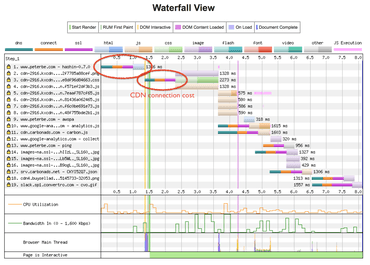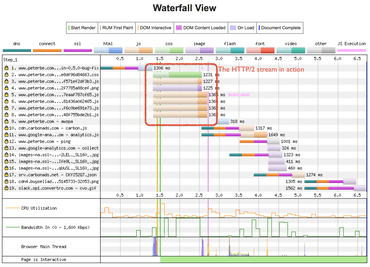HTMLMinifier in use on this blog now
August 7, 2018
3 comments Web development, JavaScript, Web Performance
Last week I enabled HTMLMinifier as a post-build step for server-rendered content here on this blog. Basically, after a page is rendered in Django, it's sent to a Celery queue that does things to the index.html file. The first thing it does its that it extracts the stylesheets and replaces them with a block of inline CSS. More details in this blog post. Secondly, what the background job does it that it sends the index.html file to node_modules/.bin/html-minifier. See the code here.
What that does is that it removes quotation marks where not needed (e.g. <div id=foo> instead of <div id="foo">), removes HTML comments, and lastly removes whitespace that is not needed. The result is that the HTML now looks like this:
I also added a line of logging that spits out a measurement of the size of the HTML size before, before with gzip, after, and after with gzip. Why? Because the optimization of HTML minification is usually insignificant after you gzip. See this blog post about how insignificant space optimization is in comparison to gzip. Look at the sample log lines:
... Minified before: 38,249 bytes (11,150 gzipped), After: 36,098 bytes (10,875 gzipped), Shaving 2,151 bytes (275 gzipped) Minified before: 37,698 bytes (10,534 gzipped), After: 35,622 bytes (10,243 gzipped), Shaving 2,076 bytes (291 gzipped) Minified before: 58,846 bytes (14,623 gzipped), After: 55,540 bytes (14,313 gzipped), Shaving 3,306 bytes (310 gzipped) ...
So this last one saved 3.2KB of HTML document which isn't a sneeze, but since 99% of clients support gzip, it actually only saved 310 bytes. As a matter of fact, I parsed the log lines and calculated the average and it was saving 338 bytes per page.
Worth it? I doubt it. It's not without risks and now it's slightly harder and weirder to view the source. However 338 bytes multiplied by the total number of visitors per month, I estimate to save a total of 161 MB of data less to be sent.
To defer or to async JavaScript tags. That's the question.
June 29, 2018
0 comments Web development, JavaScript, Web Performance
tl;dr; async scores slightly better that defer (on script tags) in this experiment using Webpagetest.
Much has been written about the difference between <script defer src="..."> and <script async src="..."> but nothing beats seeing it visually in Webpagetest.
Here are some good articles/resources:
- async vs defer attributes
- Script Tag - async & defer
- Prefer DEFER Over ASYNC
- Asynchronous vs Deferred JavaScript
So I took a page off my own blog. Butchered it and cleaned up the 6 <script> tags. It uses HTTP/2 and some jQuery and some other vanilla JavaScript stuff. See the page here: neither.html
Then I copied that HTML file and replaced all <script src="..."> with <script defer src="...">: defer.html. And lastly, the same with: async.html.
First let's compare all three against each other:

Neither vs defer vs async on Webpagetest.
Clearly, making the JavaScript non-blocking is critical for web performance. That's 1.7 seconds instead of 2.8 seconds.
Second, let's compare just defer vs. async on a 4G connection:

defer vs. async on 4G
Also, if you like here's defer vs. async on a desktop browser instead.
Conclusions
-
Don't allow your JavaScript to block rendering unless it's OK to have your users staring at a white screen till everything has landed.
-
There's not much difference between
deferandasync.asynchas a slight advantage as per these experiments. I'm only capable of guessing, but I suspect it's because it can "spread out" the work better and get some work done in parallel whilstdeferhas things that tell it to wait. In particular, since withdeferthe order of the<script>tags is respected. Suppose that the filesome.jquery.plugin.jsdownloads beforejquery.min.js, then that file has to be blocked and execution delayed whilst waiting forjquery.min.jsto download, parse and execute. Withasyncit's more of a wild west of executing whenever you can. -
The async.html is busted because of the unpredictable order of execution and these
.jsfiles depend on the order. Another reason to usedeferif your scripts have that order-dependency problem. -
Consider using a mix of
asyncanddefer.asynchas the advantage that some parsing/execution can be done by the main thread whilst waiting for other blocking resources like images.
To CDN assets or just HTTP/2
May 17, 2018
3 comments Web development, JavaScript, Web Performance
tl;dr; I see little benefit in using a CDN at this point.
I took two random pages here on my blog. One and Another. Doesn't matter what they say but it's important to notice that they're extremely similar. No big pictures. Both have 1 banner ad each. Both served with HTTP/2. Neither have any blocking linked assets. I.e. there is no blocking <link ref="stylesheet" href="styles.css"> and the script tags are are either async or defer. Both pages reference one little .png that is not deliberately lazy loaded. That's the baseline.
The HTML document, in both URLs, is served with HTTP/2 but it references a the lazy loaded .css and (a bunch of) .js files, via a CDN. In other words, it looks like this:
▶ curl -v https://www.peterbe.com/plog/hashin-0.7.0
...
> GET /plog/hashin-0.7.0 HTTP/2
...
< HTTP/2 200
...
<
...
<link rel="preload" href="/static/css/base.min.e8df96d84663.css"
as="style" onload="this.onload=null;this.rel='stylesheet'">
...
<script defer src="/static/js/blogitem-post.min.f6c0be691e73.js"></script>
...
So, cdn-2916.kxcdn.com is a an awesome CDN, but to a first-time visitor, that is going to require a DNS lookup and the creation of a new TCP connection that can be kept alive. The alternative to this is to not put any of the of the .png, .css or .js assets on a CDN. Basically, instead of <script src="https://mycdn.example.com/foo.js">, just do <script src="/foo.js">.
CDNs are really important since latency is a killer to web performance and remember that "Use a CDN" is rule number 2 in the, now dated, YSlow ruleset. However, we're entering an era where HTTP/2 is becoming more and more available in mainstream browsers (hint: nearly 100% of visitors to my site are HTTP/2 support). Buuuuuut, the latency (DNS, connection and SSL negotiation) doesn't matter that much if you have already paid those costs to get to the origin web server (https://www.peterbe.com in this example).
The Experiment
What I'm interested in seeing if there is a way to gauge/measure when it's best to use a CDN and when it's best to use the origin web server to serve all assets. My friend @stereobooster suggested: "Webpagetest.org is all you need"
Ok. Let's measure that then with Webpagetest.org and see what we can learn.
Here's a visual comparison of the two URLs when they both use CDN for the static assets.
- They load pretty equally.
- The Waterfall View looks almost identical.
- Confirmed, there are no render blocking resources as it starts to paint already at about 1.5s.
Here's a visual comparison of one using a CDN for static assets and one does not.
- They load pretty equally (diff by 0.1s).
- The Waterfall View looks very different.
- The second one does not have a second "dns - connection - ssl - download" bar.
- Almost all the
.jsare downloaded at about 1.8s when there's no CDN. - Almost all the
.jsare downloaded at about 3.0s when using a CDN. - Use the little "Waterfall opacity" widget to slide left and right to see the difference.
You can see their webpagetests individually here and here.

Two connection prices paid. Downloads individual assets faster but ultimately takes a longer time.

Only 1 connection price paid. ALL assets downloaded sooner, albeit individually slower.
Analysis
My web server is served from a highly optimized Nginx server in New York, USA. The two Webpagetest visual comparisons above are both done from Virgina, USA. But the killer feature of a CDN is that latency can be so much better thanks to edge locations of the CDN. In particular, KeyCDN have an edge location in Stockholm, Sweden. So what happens when you run the URLs from a Webpagetest machine in Stockholm, Sweden?
The both start to render at the same time (expected since the HTML document is still in New York, USA) but the (rougly) total time to download all the .css and .js is (about) 2.6 seconds when a CDN and 1.9 seconds without a CDN. In other words, despite the CDN geographically so much closer, the static assets are still available sooner without a CDN.
It's pretty clear at this point that it's not a good idea to use a CDN for static assets. Even if they're not critical. The "First Meaningful Paint" and "Time To Interactive" are about the same but when HTTP/2 can download all the .js files faster, their useful JavaScript can start being useful sooner with HTTP/2.
What Else
So in my site, it's easiest to host the whole site on an Nginx server in a Digital Ocean server. It's easy to invalidate its cache (just delete the file from disk and wait for Django to regenerate it). Another advantage with using plain Nginx is that I serve the HTML with Cache-Control headers and then do some post-processing of the .html file and since Nginx is disk-based, I don't have to update a CDN.
An alternative would be to put the whole site behind a CDN. That way, the initial HTML document can be served from a CDN edge location, using HTTP/2 and send the rest of the static assets on the same HTTP/2 connection. But this means that every single dynamic URL (e.g. HTTP POSTs or some per-user XHR requests) has to go via a CDN rather than going straight to the Nginx that is connected to the Django web server.
Last but not least, even though my Nginx server is on a decent machine and pretty well tuned, I very much doubt it's as fast and powerful as a KeyCDN or CloudFront or Akamai or Google Cloud CDN. Those servers are beasts! Mind you, the DNS + connection + SSL negotiation, when requesting from Stockholm, Sweden was about 0.75s to my Nginx in New York, USA. For the KeyCDN edge location the DNS + connection + SSL negotiation was about 0.52s. So not a huge difference actually.
Another important aspect is Service Workers. Perhaps I don't know how to hack it, but it doesn't work when you use differnet domains for the service worker .js file and the URIs it references.
In conclusion; I see little benefit in using a CDN at this point. Perhaps for larger assets like videos, GIFs or high-res images. HTTP/2 changes one of the major web performance rules. End of an era(?)
